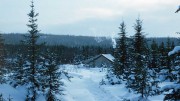In earlier columns, I referred to the Preston East Dome team and Technical Mine Consultants (TMC), which were both controlled by Joseph Hirshhorn (1899-1981). The so-called Preston East Dome team consisted of several engineers and managers from the Preston East Dome gold mine, north of Timmins, Ont. By the time Preston closed, in 1968, it had produced $57 million in gold from 6.3 million tons of ore.
At the time of the initial drilling of Peach Uranium Mines, later to be renamed to Pronto Uranium Mines, on the Long Twp. property, near Highway 17, prospector Franc Joubin (1911-1997) advised Don Smith that a geologist by the name of Bob Hart (1909-2000) would be contacting him.
It should be noted here that the main difference between Preston East Dome and TMC was that all-important commodity: money. At the time of the drilling, Preston had close to $2 million in its treasury, whereas TMC survived mainly as an in-house consulting firm with a small treasury.
Don Smith and Harry Buckles, the senior pioneers on the project, held discussions concerning the cost of a reconnaisance flight over the south belt of the “Big Z” sedimentary contact. The cost was steep, but Buckles and Smith believed the flight was necessary, even if the money had to come from their own wallets. It was then that Hart, who had overheard the conversation, stepped forward, introduced himself and offered to pay half the cost — much to the relief of Smith and Buckles.
In earlier travel to and from Elliot Lake, Smith and Buckles had come to know a conductor by the name of Metivier, whose brother had acquired a base metal prospect on Nordic Lake, not far from Elliot Lake. Metivier was aware that something was afoot in the region, but Smith and Buckles were careful never to give away their secrets. Nonetheless, they jotted down the claim numbers and the location of the property.
On the reconnaisance flight, piloted by daredevil Carl Mattaini, Smith, Buckles and Hart carefully surveyed the rocks for any sign of Mississagi quartzites, the host rocks for uranium. The flight extended almost to Sudbury, and on the return trip Smith asked Mattaini if he had enough gas for a little excursion to Little Nordic Lake to examine the Metivier claims. Mattaini agreed. The excursion itself was fruitless, though the events that followed their investigation proved fortunate.
Little Nordic Lake was too small for Mattaini to take off with three people on-board, so the pilot left Smith and Hart behind, flew the portly Buckles to nearby Elliot Lake and returned to Little Nordic to take Smith and Hart home. In the meantime, at Elliot Lake, Buckles had discovered radioactivity in the quartzites — the smoke that is usually found above the basal conglomerates that make up uranium ore deposits. (Coincidentally the Metivier claims were later optioned by TMC and became part of the Buckles uranium mine.)
Soon Hart and Smith joined Buckles at Elliot Lake. The three spread out and confirmed the original discoveries that eventually led to the Nordic mine and other contiguous uranium deposits in the Elliot and Quirke Lake areas. Smith promptly called Franc Joubin with the good news, and a summit meeting was assembled in Toronto, attended by Joubin, Hart, Buckles, William Bouck (president of Preston East Dome) and William Hutchison.
The initial planning was headed and directed by Joubin. Near the end of May in 1953, a meeting took place in a hotel room in Blind River and most of the men from TMC and Preston were present. Specific areas along the middle and upper belts of the “Big Z” were allocated to each of us, complete with crews for prospecting and staking. Later in the staking phase, the work was complemented by employees from Preston, who were on strike at the time, and flown directly into bush camps from Timmins.
And so began the “Backdoor Staking Bee,” which was a team effort if ever there was one. The key senior men in the field were Buckles, Smith and Hart. That is to take nothing away from the other Preston engineers, geologists and prospectors who supported Hart — men such as Roy Poutney, Manfred Johnson, Web Cummings, Stan Horne and Dan Firth. The main difference was that only Hart and Poutney continued to live in Elliot Lake and work for Rio Algom after the Rio Tinto buy-out. The others either returned to Preston or moved on with their careers. Hutchison and Buckles, for example, moved to Toronto to work as mining executives for Rio Algom.
In 1957, Hart was named chairman of the board of trustees for the Improvement District of Elliot Lake, and what a job that proved to be! The four members of the board met in a shack in the middle of town. Elliot Lake had grown into a lawless community without a full-time police force; indeed, the situation was such that court had to held in the town twice weekly in order to deal with escalating crime. During the week of Oct. 21, 1957, for example, the traffic accidents in Elliot Lake resulted in nine injuries, two deaths and almost $10,000 in damages.
Hart also had to deal with religious concerns, lack of housing and an overburdened infrastructure — all brought on by the tremendous influx of people into the community. Throughout this period, Hart continued to carry out his duties as general manager of Rio Algom’s Elliot Lake operations.
From 1961 to 1973, Hart headed up top management positions with Rio Algom in Canada and the U.S. He capped off his career as a consultant for Rio Algom from 1974 to 1976 and as an independent consultant thereafter.
In 1978, he received the distinguished service medal from the Canadian Institute of Mining, Metallurgy and Petroleum.
Hart passed away last year, but he will always be remembered for his crucial role in developing the Quirke and Nordic mines and for helping guide Elliot Lake through the first few years of its development.
Next week: William Hutchison.
The author, a retired mining engineer, resides in Barrie, Ont.






Be the first to comment on "Odds ‘n’ sods: Hart and Soul of Elliot Lake"